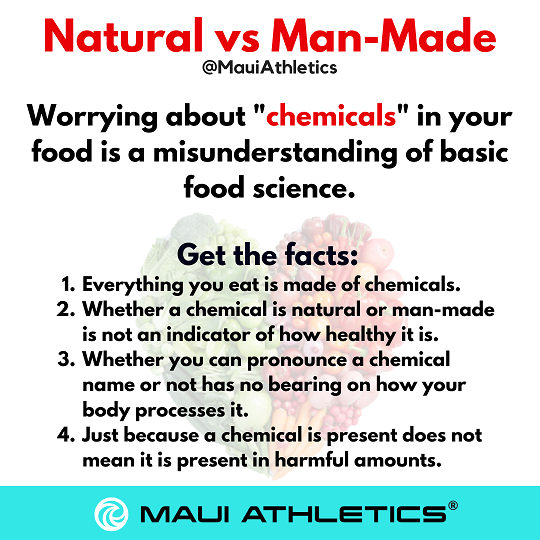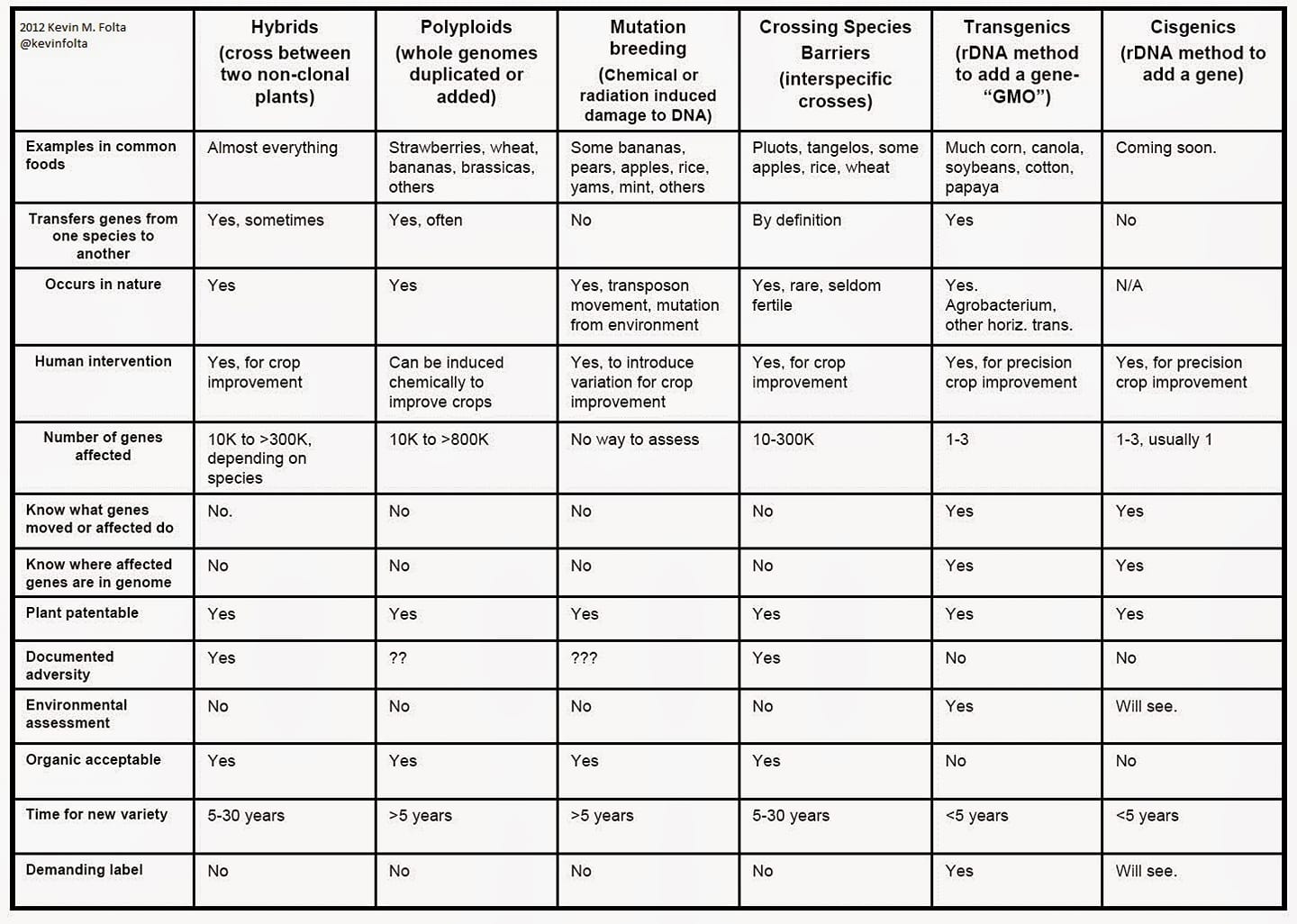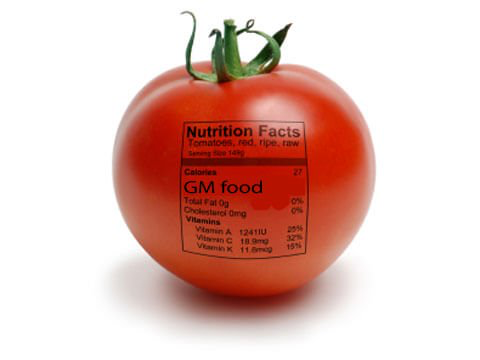Genetically Modified Organisms; Conventional vs Organic
GMO/Conventional vs. Organic
I have to admit, I have procrastinated on writing about this topic for over a year now because of the pure, illogical anger it causes in those who disagree with the research. I understand this is an emotionally charged topic, and because of this, it is nearly impossible to hold a rationale conversation…but I will do my best to present this as objectively as possible. And even if this makes you uncomfortable, maybe it will give you a good starting point to understand what the science actually says without the emotional spin. I hope this helps.
Let’s pull off that bandaid: “Extreme opponents of GMO foods know the least about genetics and science, but think they know the most. There is widespread agreement among scientists that genetically modified foods are safe to consume and have the potential to provide substantial benefits to humankind. However, many people still harbour concerns about them or oppose their use. In a nationally representative sample of US adults, we find that as extremity of opposition to and concern about genetically modified foods increases, objective knowledge about science and genetics decreases, but perceived understanding of genetically modified foods increases. Similar results were obtained in a parallel study with representative samples from the United States, France and Germany.”
doi.org/10.1038/s41562-018-0520-3
The very idea of genetically modified foods is enough to send some people running for the hills. Regardless of any evidence given to them, they simply cannot fathom how genetic modification can be a beneficial thing. And in most cases, trying to educate them on their cognitive mistakes leads to a back-fire effect. Rather than attempting to convince others who hold belief bordering on zealot-level religion, I’m going to use this as a dynamically growing reference where I will list the most reputable research related to the field of organic vs. GMO/conventional practices in our food supply.
If you find benefit in this, I am extremely happy to be a valuable part in your personal growth and learning. If this enrages you to your core, I’m sorry we don’t see eye to eye, but I still think you are a neat person and we should be friends.
Table of Contents
- What is Genetic Modification?
- The Appeal to Nature Fallacy
- Efficacy
- Safety/Environmental
- Nutrition
- Ethics/Morals
What is Genetic Modification?
Man has been performing genetic modification of organisms for multiple millennia. The difference with recent technology is that we now have a way to make precise modifications instead of what were essentially blind attempts with unknown consequences. There has been no time in history with safer, more effective modification practices.
Some will lead you to believe that the only process we have used in the past is selective breeding by selecting out desirable organisms to further propagate (and they swear that this practice isn’t genetic modification). Unfortunately, their opinion appears to be wrong on both counts according to formal science.
This debate may come into play because selectively bred plants are not typically considered GMO Food by labeling laws even though it is a GM process. The confusion seems to be that people are unaware there is a formal scientific definition, and then a separate definition for food labeling laws that is built more out of convenience or public opinion than actual science. That’s politics for you.
The separate definition for food labeling laws makes this distinction by basing their claim for GM off of genetic engineering itself. “Genetic engineering is a term used to describe biotechnological methods used by scientists to directly manipulate an organism’s genome. Under this definition, GMOs do not include plants or animals made by selective breeding or animals modified by being given hormone supplements or antibiotics. In fact, we do not currently eat any meat products considered to be GMO. The main goal of the majority of genetic engineering performed on food is to increase crop yield and/or to improve the nutrient value in animal feed. No genetically engineered crops on the market in the United States have been modified to be unusually large. Pictures of extremely large vegetables used to support the ‘Franken-food’ image of GMOs are probably not GMOs at all; an unusually large vegetable would more likely be created through less controversial methods of selective breeding or nutrient supplements, not genetic engineering.”1
Although selective breeding is an attempt to genetically modify an organism, it falls outside the food definition due to the imprecise nature of the process. Contrary to some beliefs, there are actually far more DNA changes with selective breeding in organic plants than GMOs experience with formal genetic engineering, this includes unintended changes.2
You can certainly look up the formal definition for yourself, but I’ll get you started by directing you to an article that shines some light on the topic. And hey, if it’s good enough for major University scientists at Harvard, Stanford, University of California, Ohio State and the like, it’s fine by me. Click here to view
Selective breeding is considered genetic modification at its core because it is an active guiding of genetic evolution. It is not naturally occurring. The plant/animal in question would not have evolved in this manner given a natural process, and would certainly not be presenting with this sequence of DNA and traits. Now, selective breeding comes with some concerns that more precise forms of genetic modification do not…for instance you aren’t actually controlling the genetic changes with a distinct level of precision.
You may enhance undesirable traits as well as desirable traits with this process. We see this in human examples of selective breeding. This is why certain populations have a much higher prevalence of Tay-Sachs or Sickle Cell. So no, we can’t say that selective breeding is somehow inherently “righteous” or “more safe”. In reality, it is less precise, and therefore if we want to be technical, it’s less safe overall.
Genetic modification constitutes a continuum of varying forms, multiple of which have been used for an extensive period of time throughout history (certainly a wider range than solely selective breeding). The following table does a good job in piecing together a variety of types on a continuum from least control on the left, to most control on the right. Note that selective breeding includes both choosing desirable traits out of a crop/animal to propagate as well as hybridization (and of course, both are still considered genetic modification by science):
The entire point of specific GM modification is to create better food products. Safer, better for the environment, and just as nutritious if not more.
Now does this mean every GM food product that will ever be created will be a success? Absolutely not. This is similar to how not every selective breeding attempt will be successful. But that’s why we have stringent testing and safety procedures in place. To ensure the viability, safety, and nutritional quality of the food products that end up on the market.
The “Appeal to Nature” Fallacy
The appeal to nature is a logical fallacy that occurs when something is claimed to be good because it’s perceived as natural, or bad because it’s perceived as unnatural. It is generally considered to be a bad argument because the unstated primary premise “What is natural is good” is typically irrelevant, having no cogent meaning in practice, or is an opinion instead of a fact.
There are literally millions of ways to point out how ludicrous this argument is. Cyanide is natural, does that mean it’s healthy? Medications are unnatural, does that mean they are unhealthy? The problem is that when a person is prone to appeal to nature fallacies they are viewing the world through an altered lens of their own creation rather than viewing it for what it is. So logical arguments tend to be brushed aside in preference for their pre-conceived viewpoints. It is easy for them to accept unnatural things they enjoy and dismiss natural things that they do not.
We see the same argument regarding “chemicals” or other “unnatural” things in our food supply. The problem with this type of thinking is it shows a misunderstanding of basic food science. Everything we eat is a chemical. Likely everything in our food supply (even organic food) is already a genetically modified organism to one extent or another.
Whether it’s a transgenic organism or a chemical name you can’t pronounce, the same holds true: these are not determinants of whether a food item is healthy or not. Food items should be evaluated on an individual basis to assess true health effects, regardless of perceived status of how natural they are.
My infographic on chemical fear-mongering tends to work just as well for GM fear-mongering since both deal with this false “natural vs man-made” health dichotomy:

Efficacy
This isn’t a very contentious topic. Most people know Conventional grows much more readily and efficiently than Organic.
“On average, GM technology adoption has reduced chemical pesticide use by 37%, increased crop yields by 22%, and increased farmer profits by 68%. Yield gains and pesticide reductions are larger for insect-resistant crops than for herbicide-tolerant crops.”
doi.org/10.1371/journal.pone.0111629
“Organic crops have 34% lower yields (when the conventional and organic systems are most comparable).”
DOI: 10.1038/nature11069
Safety/Environmental
The topic of safety and environmental impact is a difficult one to navigate (although it shouldn’t be since there is a mountain of evidence suggesting GMO is safe including over 25 years of safety endorsements from 280 science institutions and more than 3,000 studies3).
Part of the reason there is confusion is because there are a host of potentially toxic organic pesticides that organic farms are not required to track as stringently as their GM counterparts. What this leaves us with are gaps in the knowledge where, in some studies, organic food can appear to have less pesticides overall…when in reality they may have more overall pesticide usage and particularly more toxic pesticide usage.
The good news is, regardless of the levels that have been detected on either GM or Organic crops in the literature, none have been at a level that is concerning for consumption to the end user. So arguing over which is better from a pesticide exposure perspective is a moot point from the start.
The other argument you will hear the organics try to pull here is that conventional or GM food lowers biodiversity. This is another manipulation used by the organic lobby to try to trick people into believing organic is somehow better for the world.
I am fully aware of the studies that “show” this. What the studies are not mentioning in their Conclusion sections is that they include weeds in their criteria for biodiversity. So if we look at the information as “Conventional farming ends up with less weeds”, and therefore that means it has less biodiversity, then yes it is true. The problem is this is a disingenuous claim since that’s exactly the point. GM crops are weed and pest resistant. If the lessened biodiversity means there are less weeds, well that’s intended. Less weeds and less pests also mean they require less pesticide use and also less toxic pesticide use to control the lesser challenge they face.
“There is no scientific research connecting GMO crops to significant health or environmental hazards. This includes over 30 years of data.”
DOI: 10.3109/07388551.2013.823595
GE maize varieties have increased crop yields worldwide 5.6 to 24.5%, as well as had significantly fewer (up to 36.5% less) mycotoxins, fumonisin (−30.6%), and thricotecens (−36.5%) – toxic chemical byproducts of crop colonization from invasive fungi, thus reducing human health risks. Reduction of the parasitoid of the target, no negative impact on soil microbial biomass and activity, and the lack of consistent effects on other non-target organisms are also confirmed.
doi.org/10.1038/s41598-018-21284-2
“We have reviewed the scientific literature on genetically engineered (GE) crop safety during the last 10 years, built a classified and manageable list of scientific papers, and analyzed the distribution and composition of the published literature. We selected original research papers, reviews, relevant opinions and reports addressing all the major issues that emerged in the debate on GE crops, trying to catch the scientific consensus that has matured since GE plants became widely cultivated worldwide. The scientific research conducted so far has not detected any significant hazards directly connected with the use of GE crops. An improvement in the efficacy of scientific communication could have a significant impact on the future of agricultural GE. Our collection of scientific records is available to researchers, communicators and teachers at all levels to help create an informed, balanced public perception on the important issue of GE use in agriculture.”
DOI: 10.3109/07388551.2013.823595
Although there is some varied evidence that organic foods may reduce exposure to pesticides or other “chemicals,” anything non-organically consumed is still well below safe limits for consumption. “No differences can be identified for environmental contaminants (e.g. cadmium and other heavy metals), which are likely to be present in food from both origins. What should be made clear is that ‘organic’ does not automatically equal ‘safe.'”
DOI: 10.1080/10408690490911846
The deployment of Bt-GM crops has little or no effect on biodiversity of soil organisms. Changes in soil microbes are indistinguishable or can be explained by the effect of temperature, soil type, or other unrelated parameters. No significant adverse effects of Bt-GM crops on non-target organisms or beneficials has been detected in the field. Controlled studies only observe effects of Bt-GM crops on natural predators or parasites if they feed on a living insect which is damaged by feeding on Bt-GM plants, and that in the field these effects are not observed. In some areas, Bt-GM crops predominate the landscape, the populations of the targeted pests decline to levels that benefit nearby farms that grow organic crops to the extent that they can lower the level and frequency of the insecticides they deploy.
PMID: 25665234
“These data bring into caution the widely held assumption that organic pesticides are more environmentally benign than synthetic ones. All pesticides must be evaluated using an empirically-based risk assessment, because generalizations based on chemical origin do not hold true in all cases.”
DOI: 10.1371/journal.pone.0011250
“The research that has been conducted in studies with animals and on chemical composition of GE foods reveals no differences that would implicate a higher risk to human health from eating GE foods than from eating their non-GE counterparts. There is some evidence that GE insect-resistant crops have had benefits to human health by reducing insecticide poisonings and decreasing exposure to fumonisins. New methods to measure food composition that involve transcriptomics, proteomics, and metabolomics provide a broad, nontargeted assessment of thousands of plant RNAs, proteins, and compounds. When the methods have been used, the differences found in comparisons of GE with non-GE plants have been small relative to the naturally occurring variation found in conventionally bred crop varieties. Differences that are detected by using -omics methods do not on their own indicate a safety problem.”
ncbi.nlm.nih.gov/books/NBK424534
This paper examined almost 900 research and other publications. They found no evidence that genetically engineering crops adversely impacts human health. In fact, crops bred to be insect resistant may have benefits to human health by reducing insect poisonings, and genetic engineering of rice has increased its beta-carotene content to help prevent vitamin A deficiencies in developing nations.
DOI: 10.17226/23395
While most GMO research hasn’t found evidence of harm, the handful of studies that report an adverse effect often don’t adjust for multiple comparisons. This statistical error increases the chances of a false positive. Much of the controversy surrounding GMOs and human health stems from a study published by Gilles-Éric Séralini in 2012. Supposedly, he found that rats fed GMO corn developed more tumors than control rats. His paper was later retracted – his statistics were heavily criticized, and he chose (from the start) rats prone to tumors regardless of food source. After making the appropriate statistical correction, differences between GMO and non-GMO groups in studies like (and including) Séralini’s generally become non-significant, and therefore it can be concluded that there has not been shown to be health concerns with GMO food items.
DOI: 10.3109/07388551.2015.1130684
“GM products do not appear more allergenic than their conventional counterparts as determined by IgE binding studies in well-characterized sera from humans with allergy and animal models, case series of direct provocation and ingestion, and simulated digestion studies. These are methods approved by the World Health Organization for determining allergenicity of GM products.13 We did identify limited evidence that genetic modification, in some instances, resulted in the product having decreased IgE binding capacity in subjects with allergy compared with its conventional counterpart, which could indicate hypo-allergenicity, although this concept requires more robust study. It is important to emphasize that known allergens to an individual, be it in a GM form or conventional form, will still be allergenic in that individual and it should be avoided. This review also highlights that there is no evidence that eating GM products in individuals who are not allergic to conventional forms of those items would result in allergy or increase the risk of developing an allergy to that item.”
doi.org/10.1016/j.anai.2017.07.010
Nutrition
This can be a particularly contentious topic, mainly because people don’t understand what they are looking at when presented with the data.
There are certainly instances where things like anti-oxidants, omega-3 levels, and polyphenolics have been suggested to be higher in organic foods compared to conventional. The issue with taking this at face value is that the relative differences tend to be very small to inconsequential when you investigate further. The health difference in omega-3 content between organic and conventionally raised beef, for instance, is so paltry that what sounds like a large % increase ends up not being worth anything to your actual health.
Let’s use a car buying analogy to help explain this. Say purchasing a car is our equivalent of yielding a positive health outcome. You are trying to buy a car that costs $25,000. At $25,000 you get a practical health benefit. Now I tell you I can give you a job that will increase how much money you have by 200%. Well that sounds like a great deal, and you’ll surely be able to buy that car then!
Unfortunately, you’re only worth $100. So that 200% increase means you now have only $300. Still a far way off from buying that car, but it sounded like a big win initially. This is one of the tactics the organic lobby uses to trick people into thinking they have a nutrition advantage over conventional food. Marcin Barański research tends to come to mind.
Given the breadth of data, and the lack of definitive evidence over a large number of systemic reviews, it is unlikely that organic foods are significantly healthier than conventional. So why do we see some variance in nutrition levels in certain studies?
It appears that farming practices (such as crop rotation, and hence soil quality), type of plant fertilization, ripening stage and plant age at harvest, and weather conditions have an influence on nutritional value and taste. These likely account for the actual differences in nutrition rather than an issue with conventional vs. organic.
I’ve broken down every major systemic review on the nutritional status of organic vs. conventional produce in my infographic here for your ease of reference. The real take-away here is that if organic was truly more nutritious, we would likely eventually see that become more clear in the data (we haven’t):
“Organically labeled vegetables are considered by many consumers to be healthier than non-organic or ‘conventional’ varieties. The purpose of this study is to examine the nutritional quality of broccoli using vitamin C, a fragile and abundant nutrient, in broccoli as a biomarker. These samples were obtained during different seasons when the broccoli could be either harvested locally or shipped far distances. The findings indicate that vitamin C could be used as a marker under a controlled laboratory environment with some limitations and, although the vitamin C content of organically and conventionally labeled broccoli was not significantly different, significant seasonal changes have been observed. The fall values for vitamin C were almost twice as high as those for spring for both varieties. The seasonal changes in vitamin C content are larger than the differences between organically labeled and conventionally grown broccoli.”
DOI: 10.1080/09637480701453637
“On the basis of a systematic review of studies of satisfactory quality, there is no evidence of a difference in nutrient quality between organically and conventionally produced foodstuffs. The small differences in nutrient content detected are biologically plausible and mostly relate to differences in production methods.”
DOI: 10.3945/ajcn.2009.28041
There is no difference in taste between conventional and organic in double-blind taste tests. Organic may be better tasting since it must be harvested closer to time of peak ripeness because they spoil quicker, not because it is organic.
doi.org/10.1016/j.foodqual.2013.01.010
Ethics/Morals
There are a few ethical or moral arguments that could be made against companies that sell genetically modified organisms (although I believe boycotting life-saving technology for the masses to get back at a corporation is cutting off your nose to spite your face). One such issue I have already addressed above is the case of biodiversity-loss related to GMO tech since it does not allow as much weed growth as organic. (Those poor weeds.)
Another argument I see regularly is the concern over anti-biotic resistance in animals. As discussed earlier, this is a farming practice issue, rather than GMO vs. Organic since both can use anti-biotics.
Now there is certainly a concern over this when anti-biotic use is abused, similarly to how abuse of pesticides could cause health and environmental issues. The FDA has specific guidelines in place to help prevent or minimize this issue.
The FDA’s 2015 Veterinary Feed Directive and FDA’s Guidance for Industry #213 in 2017 significantly changed the way medically important antibiotics can be used in food animals. When the changes were fully implemented, it became illegal to use medically important antibiotics for production purposes, and animal producers now need to obtain authorization from a licensed veterinarian to use them for treatment, prevention, and control of a specifically identified disease.16,17
A second biodiversity angle that organic proponents try to argue, from an ethics standpoint, suggests that farmers are forced into buying specific seeds annually from GMO companies. Unfortunately this is inaccurate as well. Farmers, both organic and conventional, choose to buy new seeds yearly for very specific reasons.4 They have for nearly 100 years if not longer. This practice was even promoted by Henry Wallace, Franklin Roosevelt’s Secretary of Agriculture (long before modern GE products reached the scene).
No competent farmer would want to save seeds or would willingly buy second generation seeds. There is no requirement to do this by Monsanto or any other big name corporation; buying new seeds yearly is standard farming practice that has been in play long before GMO’s became commonplace.
The reason this would not happen is because of a phenomenon called hybrid vigour (remember when we talked earlier about hybrids being considered organic from a food labeling perspective?). The first generation after a cross yields a much better product with a much more reliable set of traits. This is why nearly all, if not all, commercial varieties of seeds are hybrids (both organic and conventional). If you plant saved seeds, the yield is significantly lower than if you simply bought new seeds. In addition to this, most new seeds (both organic and conventional) come with a germination rate guarantee.
Saving seed is both unnecessarily risky and incredibly costly when you add in the time, storage fees, and cleaning of what could be hundreds to thousands of acres in a single farm. Re-using seeds or buying second gen seeds means more expense, less quality produce, and far more work for the farm. Not even organic farms fall for that. This saving seed argument is something made up by people who have never even seen a farm, let alone worked one.
To throw a curveball into the mix here, I want to transcribe a favorite article [edited by me] from the American Council on Science and Health written by David Zaruk. What organic activists and the organic food industry do on the daily is nothing short of comic book supervillain levels of evil. This article details why it is unethical and immoral to buy organic food.
At the time of this writing, the article itself is unavailable to link due to server upgrades they are making, but Cheryl E. Martin, the Director of Operations at ACSH, was kind enough to send me a copy via e-mail to share with everyone. The article is titled 20 Reasons Not To Feed Your Family Organic, and I feel it makes some very valid points on why you should actively choose not to buy organic foods. Enjoy:
1] Organic is overly expensive for no difference in quality. Given the average lower yields from organic farming, the higher risk of crop failure tends to be priced into the market. Others would say organic has become a green designer label but this seems to contradict the second element, that organic is of a lower quality. Many pesticides/herbicides are used to keep organic produce looking good & edible and to prevent them from rotting on the branches. Food is emotional. So for many, quality in appearance is important.
2] Organic uses more land with lower yields, reducing biodiversity. Depending on the crop and the region, organic farming tends to yield between 19-60% less than conventional farming (see a list of recent academic studies). If we were to convert all farms to organic, we would have to do two things: prepare for less food or plough under more meadows and forests. With a growing global population, it would be advisable to rely on technology rather than eco-religion. Higher yields on less land, allowing for larger habitat restoration, seems a better solution to me.
3] The organic industry uses unethical lobbying tactics. Too many to list here, but much of their work involves emotional manipulation of the populace at large to both sow disinformation and influence policy. To be fair, I feel this is likely an issue in every industry.
4] Pesticides approved for organic farming are toxic to bees (this is a big deal). One very common misconception is that organic food contains no pesticides. Of course they do, otherwise organic farmers would grow food only to feed the insects and remediate the soil. In most countries, pesticides are permitted in organic farming if they come from a natural source (and thus not of a synthetic origin). In some cases, these natural substances can be synthetically manufactured although it depends on each country’s standards. In order to combat pest infestations, fungus, and mold, organic pesticides need to be toxic (another point the organic industry lobby has not been very forthcoming on). The eco-version of the appeal to nature fallacy assumes that anything natural is benign and acceptable, but many organic-approved pesticides are far worse for the environment than well-tested synthetic substances. Pyrethrins, sulphates, and nicotine are all meant to kill, and are not harmless to the environment. Two organic pesticides (Rotenone and Azadirachtin) are extremely toxic to bees and the organic lobby has fought to keep them on the market (See Reason 3).
5] Pesticides approved for organic farming are toxic to humans (likely more dangerous than GMO). There are two ways to explain this. As in Reason 4, pesticides derived from a natural source are also toxic, in some cases much less tested because we rarely test natural chemicals (click here). Rotenone, as mentioned above, has been clearly linked to Parkinson’s disease. The health risks of ingesting pyrethrins are also troubling. About 99.9 percent of the chemicals humans ingest are natural. The amounts of synthetic pesticide residues in plant food are insignificant compared to the amount of natural pesticides produced by plants themselves. Of all dietary pesticides that humans eat, 99.99 percent are natural: they are chemicals produced by plants to defend themselves against fungi, insects, and other animal predators. Bruce Ames has some interesting work in this area. I’m not saying to worry about natural pesticides, only that worrying about synthetic pesticides is losing sight of the forest for the trees.
6] Research shows no difference, at all, in taste, health or safety. We covered this above.
7] Organic has higher tillage which releases more CO2. Given that organic farmers do not use herbicides, they need to till the land more frequently to control weeds. This of course consumes more tractor fuel (although we want to believe organic farmers use solar-powered tractors), but also, increased tillage separates microorganisms in the soil, releasing them into the atmosphere. Click here for a list of carbon-challenges for organic farms.
8] Promotes child labor in Africa. This is an endemic issue in many African subsistence farming communities. Click here for a breakdown of child labor in Africa related to farming. Only 5.4% of European agricultural land use is organic, while the market for organic is growing much faster. African family farms are organic by default (due to the high cost of pesticides and fertilizers as well as pressure from EU import/export regulators to deny African agriculture the benefits of using modern technologies like GMOs). While the focus of child labor in Africa has largely been on cocoa production from West Africa, the inability of Europe to be able to feed itself (due to an absurd reliance on medieval agricultural technologies) has led to an increase of African organic agricultural exports. The organi-gurus seem content in denying this correlation when they choose organic, pretending they are not actually supporting those little hands that are manually pulling out the weeds and breaking off pest-ridden leaves rather than going to school. They argue to choose local, but you just can’t grow enough locally to meet demand. GM farming not only saves children’s health, it saves them from cruel working conditions and abuse.
9] Anti-GMO / anti-pesticide/herbicide research is based on poor activist science. A traditional scientist gathers the evidence and draws a conclusion. An activist scientist starts with the conclusion and searches for evidence. We have seen some very ethically challenged activist science accepted into the mainstream, including scandals around the neonicotinoid/bee health research, the IARC glyphosate debacle (glyphosate has never actually been shown to be dangerous by legit science when usage directions are followed)6-15, Barański research, and the retracted Séralini study that I mentioned earlier as examples of these very issues. All of these were funded or influenced by organizations tied to the organic industry (see Reason 3).
10] One year of GMO pesticide residues is less toxic than one cup of coffee. More fun info from Bruce Ames. “A cup of coffee is filled with chemicals. They’ve identified a thousand chemicals in a cup of coffee. But we only found 22 that have been tested in animal cancer tests out of this thousand. And of those, 17 are carcinogens. There are 10 milligrams of known carcinogens in a cup of coffee and that’s more carcinogens than you’re likely to get from pesticide residues for a year!” The point is that the risk from synthetic pesticides at the maximum residue exposure levels is practically meaningless. It is no surprise that caffeine is ten times more toxic than glyphosate. A lot of other natural chemicals are far more toxic, but the organi-gurus are too busy scaring people to realize this. One little addendum that makes today’s anti-pesticide/herbicide campaign seem even more ridiculous: Ames made this statement in 1990. Considering that synthetic pesticides were far more toxic then than they are today, we might need to radically revise Ames comparison downwards (perhaps to the equivalent of a sip of coffee today).
11] GMOs literally save lives. Anyone who takes medicines every day or injects insulin to fight diabetes with the hope of enjoying a higher quality of life appreciates the achievements of biotechnology. Plant biology is no different, no matter how the opportunists try to scare it up with the M (Monsanto) word or calling them chemicals. We have a technology that can increase food supply, reduce hunger, fight diseases like Vitamin A deficiency that kills half a million children a year, and neo-Luddites are going around shouting slogans, destroying test fields and spreading falsehoods in their witch-hunts. History will look back and scoff at this period. The most ridiculous element of the organic lobby’s jump into the GMO debate is that GM technology is a tool for reducing both organic and conventional pesticide use. It should be welcomed as a scientific advancement for organic farming. Instead they have created a fiction, to milk the anti-Monsanto crusade, that GMOs lead to more pesticide use, and that glyphosate causes all sorts of diseases. This is completely false. Click here for more info.
12] Hormone scaremongering is overplayed. The Center for Veterinary Medicine has confirmed that 1 pound of farmed beef from cattle given a common hormone, estradiol, contains 15,000 times less estradiol than the estrogen produced daily by the average man and 9 million times less than that produced by a pregnant woman. There are strict regulations in place for steroid use in cattle. When compared to meat and milk that come from animals raised without hormones, the difference is…there is none. The USDA, the Academy of Nutrition and Dietetics and the Journal of Clinical Nutrition have all stated that beef from natural and organic programs is not safer, more nutritious, more wholesome or different in appearance compared to beef from animals that have received steroid implants.
13] Higher levels of pollutants in groundwater found from organic fertilizers. Organic farmers only use cow, pig and poultry manure and other natural composts to fertilize their fields. This runs off into surface and groundwater, increasing nitrate and acidic levels which can have enormous consequences on local ecosystems. Conventional farmers have the option to use synthetic fertilizers which, when used precisely, are more efficient for direct nutrient management, emitting far fewer pollutants and reducing CO2 emissions. Add this to the far less studied nature of these organic contaminants and this becomes a possible shit storm brewing (pun intended).18-21
14] Organic farming has led to serious E. coli outbreaks and fatalities that are avoided with GMO. The over-emphasis on cow manure in organic farming has led to many serious human health crises, including most importantly, E. coli outbreaks due to fecal contamination from manure. A study comparing organic and conventionally farmed vegetables found E. coli traces on 10% of organic but only 2% of conventionally farmed vegetables.5 Indeed, bacteria are natural and organic consumers need to understand that natural is not always desirable. One of the worst cases traced back to organic farming affected 4000 people, killing 53. And they paid more for that food, that’s really rubbing pink Himalayan salt in the wound.
15] Organic food causes increased cancer susceptibility. Since organic appears to have no practical health benefits (outside of psychological), by artificially interfering with the agricultural marketplace and campaigning to handcuff conventional farming, the organic lobby is putting price pressure on the availability of fresh fruit and vegetables. While this does not affect the arrogant, affluent FoodBabes of the world, it denies a significant part of the population from access to cancer-fighting micronutrients. Our friend Bruce Ames has something to say on this as well. He found the lowest 20% income bracket in the US had the highest cancer rates. Excluding lifestyle issues like smoking, diet and particularly the lack of access to fruit and vegetables was the highest contributing factor to cancers. Ames conclusion from his research is to increase access to fruit and vegetables for the poorest population to help treat this life threatening issue.
16] Animals suffer when denied medicine. This is the barbaric face of Big Organic. Fearing the overuse of antibiotics in livestock management, organic activists like the FoodBabe are demanding that large retail and restaurant business source only drug-free meat. Animals, like people, get sick, and when a child is suffering from an illness, most parents would want to ease that suffering with medicines (including antibiotics if serious). So too with animals. That organic requirements or standards in many countries forbid such interventions means animals will suffer for some rich person’s narrow self-indulgence in steak purity.
17] Reduction in agricultural yields creates more global food insecurity. This is a no-brainer and perhaps the strongest reason we should prevent the selfish endeavor of encouraging organic farming. With a growing global population, yields per hectare need to be going up, not down. We have had the good fortune of not having any significant crop failures in recent history and therefore there has been little impact on global food reserves. But as more extreme weather conditions increase, the idea that we can be complacent about food production levels is troubling. Besides weather and disease outbreaks, there are also man-made stresses that play havoc with global food security. Fuel disruptions such as those that come with embargoes on Eastern European energy producers can certainly add in to global supply chain issues. Rising demand for lower-yielding organic food production will irresponsibly add stress to the global food production levels. The organic lobby’s reply is smug and cynical: there is no problem, we just need to reduce food waste (or I guess lower population levels?). Consider what would happen if Coca-Cola bowed to activist pressure and committed to sourcing only organic, non-GMOs. It would be impossible to produce sufficient maize for this one global client and prices in poor countries would go through the roof…essentially making it so those African children who are being worked to death to feed Europe now have no food even for themselves.
18] Organic accentuates social exclusion. The affluent do not think about the consequences of their actions on the poorer classes. As prices increase on food and choices go down, will the organi-gurus feel sorry for those without? As Vivienne Westwood said: poor people should eat less so they can afford organic food. (Yes, that is an actual quote.)
19] Exporting anti-technology ideologies on poor economies is immoral. Putting organic, anti-GMO demands on poor, developing countries is immoral. No need to look any further than the campaigns against golden rice.
20] Organic campaigns create an unfair prejudice of conventional farmers. Pro-organic groups like Pesticides Action Network or Friends of the Earth are trying to portray conventional farmers as industrial farming or faceless factory farms. They have created a public villain, indiscriminately pouring chemicals down the throat of Mother Nature, mistreating poor animals and not caring about nature or our health, but only big, Monsanto-sized profits. This is contrasted by the saintly, bucolic image of the organic farmer, who loves the land, is concerned for our health and earns just enough to support his children who will lovingly take over the homestead some day.
You are perfectly free to choose to eat organic if that makes you feel good and you can afford it, and if you can live with the consequences and contradictions. But if you want to influence others to do the same, then you have to address these 20 points, not with feelings, anecdotes and stories, but with facts. It would be more intellectually honest to realize flaws in arguments than to continue to push bad ideas that have enormous consequences for the sake of fundamentalist purity.
Citations
- https://sitn.hms.harvard.edu/flash/2015/how-to-make-a-gmo/
- doi.org/10.1104/pp.111.173609
- https://geneticliteracyproject.org/2022/01/21/gmo-20-year-safety-endorsement-280-science-institutions-more-3000-studies/
- https://geneticliteracyproject.org/2017/08/23/viewpoint-farmers-not-trapped-annually-buying-patented-gmo-seeds/
- DOI: 10.4315/0362-028x-67.5.894
- forbes.com/sites/geoffreykabat/2017/10/23/iarcs-glyphosate-gate-scandal/
- reuters.com/investigates/special-report/who-iarc-glyphosate/
- https://www.ncbi.nlm.nih.gov/pmc/articles/PMC5515989/
- epa.gov/ingredients-used-pesticide-products/glyphosate
- acsh.org/news/2017/10/24/glyphosate-gate-iarcs-scientific-fraud-12014
- geneticliteracyproject.org/glp-facts/iarc-international-agency-research-cancer-glyphosate-determination-world-consensus/
- cdn.who.int/media/docs/default-source/food-safety/jmpr/jmpr-summary-report-may2016.pdf?sfvrsn=48625631_5
- fao.org/3/i8267en/I8267EN.pdf
- https://mauiathletics.com/wp-content/uploads/2022/07/Glyphosate-1.jpg
- https://mauiathletics.com/wp-content/uploads/2022/07/Glyphosate-2.png
- https://www.cdc.gov/drugresistance/food.html#:~:text=About%20Antibiotic%20Use%20in%20the%20Food%20Supply&text=Antibiotics%20are%20valuable%20tools%20for,needed%20to%20treat%20foodborne%20illnesses.
- https://www.fda.gov/animal-veterinary/development-approval-process/veterinary-feed-directive-vfd
- DOI: 10.5194/hessd-10-9915-2013
- doi: 10.3390/w15162895
- PMID: 22906701
- doi: 10.1016/j.emcon.2023.100207











